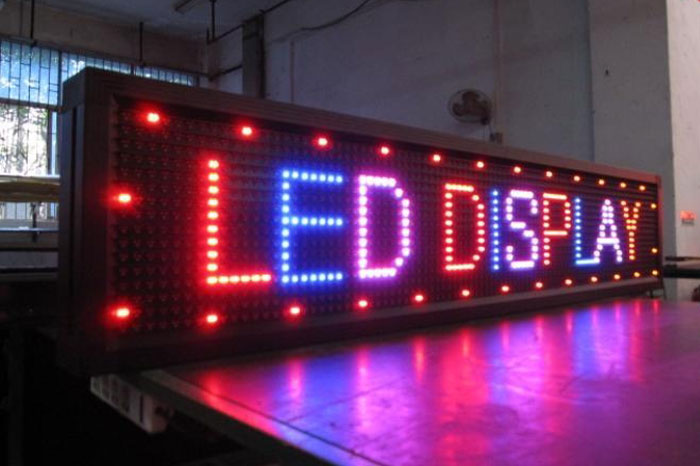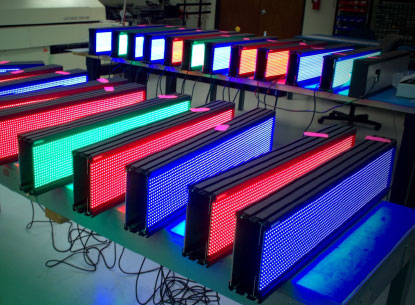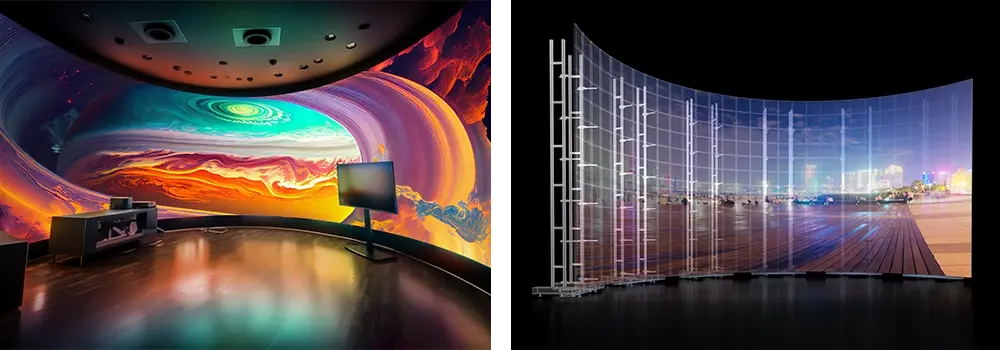New Suggestions For Choosing Quality Rental Led Display
New Suggestions For Choosing Quality Rental Led Display
Blog Article
How Important Is The Brightness And Contrast Ratio When Analyzing Led Displays?
Take into consideration the brightness and contrast ratio when looking at LED screens as they can have a huge impact on the quality of display and the way it looks, especially under different lighting conditions. This is why they're so important:
1. Visibility in Various Lighting Conditions
Brightness The measurement is in candelas (candelas/square meter) and is used to determine the brightness of the display under different lighting conditions. Outdoor displays should have a high level of brightness, usually ranging from 5,000 to 10,000 nits. Indoor displays require less brightness (usually 500-1,500 nits). However it is possible for the brightness to be adjusted to fit different conditions.
Application Displays that will be used in brightly lit environments or outdoors, high brightness is non-negotiable. The display could be ineffective if the brightness is not high enough. The content may wash out by direct sunlight, or disappear.
2. Image Quality and Clarity
Contrast Rate Contrast Rate: The ratio of the contrast is the difference which can be created between the most brightly lit white screen and the darkest. A greater contrast ratio increases the clarity and sharpness of images, and makes colors more vibrant. This is particularly important when displaying content that is dynamic such as videos or images that are high-contrast.
Displays with a higher contrast ratio handle complex content better such as movies, ads, as well as live broadcasts. With a display with low contrast for instance dark areas can appear grey and decrease the impact of the image.
3. Color Accuracy and Visual Impact
Brightness and Color Accuracy: Brightness also is a factor in color accuracy. A display with a consistent and adequate brightness can reproduce colors more accurately. This is vital for advertising, branding and content that requires accuracy in color.
High contrast can increase the apparent brightness. Even if two screens sport the same nit ratings (or brightness), the screen with a higher contrast ratio will appear more vivid.
4. Energy Consumption
Brightness and power efficiency: Higher brightness levels usually require more energy. It's therefore important to balance brightness requirements with energy efficiency, particularly for displays that operate 24/7 or are part large-scale installations. Thanks to advances in LED technology, displays now can be more efficient in energy use and provide the highest brightness.
5. Content Versatility
Brightness for different types of content: Depending on the content type--text or static images, or dynamic video--the demands for brightness and contrast may differ. Text-based content benefit from a high contrast, which facilitates reading. However, video content might require a mix that is able to balance brightness and contrast.
Application The ability to adjust levels of brightness and contrast can be beneficial in environments where content changes frequently, such as advertising screens or event displays. This allows the display to adjust itself to the different needs of the content.
6. User Experience
Brightness Adjustability: Displays with automated or manual brightness adjustments can provide a more user-friendly experience by adjusting to changing ambient light conditions all day. The display will always be bright and visible, without glare or eye strain.
Contrast and Eye Comfort: A high ratio of contrast can reduce eye stress, making the display more interesting for extended periods. This is crucial for displays in public areas, events, and retail environments.
Conclusion:
The brightness and contrast ratio of an LED display is essential to function effectively in its intended environment. This will ensure that the information is clear, vibrant and simple to read. These aspects, like whether the display will be used indoors or out and in brighter or darker settings can have a significant influence on its performance and the experience for the viewer. The balance between energy efficiency and the requirements of content will allow you to select the right display for your needs. Follow the best cob led display for site tips including transparent led panel, display screen led, led display transparent, transparent screen monitor, outdoor led display screen, led display device, led screen transparent, wall screen, led transparent display, led in the wall and more.
What Is The Importance Of The Angle Of View When You Are Searching For Led Displays?
It is important to think about the viewing angle while researching LED displays. Particularly for situations where it will be viewed on a variety of angles and from different positions. The reason why viewing angles are crucial:
1. Uniform Image Quality
Definition: The LED display's viewing angle refers to the highest angle at which an acceptable display performance can be observed (normally in terms of the brightness and consistency of color). The viewing angle is determined in both horizontal and vertical directions.
It is important to have a wide viewing angle. This ensures the quality of the image will be the same regardless of what position you're sitting in relation to your display. This means that colors don't change and brightness doesn't drop dramatically when viewing from the side or above/below.
2. Audience Experience
The impact of large venues. Large spaces, like arenas, concert halls as well as conference centres, audience members are spread out over a broad space. The smaller the angle of view the worse for those seated at an angle that is sharp towards the screen.
Application: In large-scale events or installations where the audience is placed within an arc of large size an extended viewing angle is necessary to ensure that everyone get a clear, vibrant image of the material being shown.
3. Suitability for Public Spaces
Public Display Applications For settings such as shopping malls, transportation hubs, or outdoor advertising the angle of view is vital since people are viewing the display from all angles. A small viewing space would restrict the capacity for the display to be engaging and attract passersby.
Application Digital signage for public places can benefit from a broad viewing angle that can increase the impact of the display and make the content more visible and appealing.
4. Content Consistency
The uniformity of color and brightness: Displays with poor viewing angles may show color shifting or loss of brightness when viewed at an angle other that the central. This can be a problem when content is linked to brands, and where color accuracy and consistency are essential.
Application Wide viewing angle is ideal for settings where brands must be consistent and have an identity, such as corporate or retail environments.
5. Installation Flexibility
Possibilities for Placement Wide viewing angles provide more flexibility regarding where they can be installed. It can be used in many different innovative ways, like to wrap around columns or put it in a place where people will approach from all directions.
Application Wide viewing angles are ideal for LED displays that are used in creative or architectural applications such as those in museums, galleries or other immersive environments. They permit greater creativity, but without compromising the experience of the user.
6. Renting and staging using Performance
Event Settings - For rentals and in stage settings, where displays are placed in various venues and settings, a large viewing angle guarantees that the display will work consistently in every setting regardless of the location of the audience.
Application: For events or trade shows that draw audiences that move or for events in which people are watching the display in different places, a wide-angle view ensures everyone can see the content clearly.
7. Impact on ROI
Maximizing visibility: A screen with a wide viewing angle will attract a wider audience and increase its impact, which in turn can improve the return on investment. This is important, especially for informational displays and advertising screens. It is crucial to maximize visibility in order to attain the desired results.
Application: In a commercial installation, increasing engagement by making sure the display's visibility is maintained from multiple angles can increase the quality of content displayed.
Conclusion:
The angle of the view is a critical factor which directly affects the efficiency of an LED display. It is crucial in environments in which there are a lot of people, the display can be seen from different angles or content consistency is vital. To find the best LED display for your project it is essential to select a wide viewing range. Have a look at the recommended quality rental led display for site examples including led panels, flexible led display, outdoor led monitor, outdoor display led, led outdoor display screen, transparent led screen display, led panel rental, outdoor led monitor, transparent screen monitor, led board rental and more.
What's The Purpose Of A Content Management System?
The compatibility of LED displays with the CMS (Content Management System) are crucial when analyzing their use, especially for applications in which content is frequently updated, distributed across several locations, and integrated with digital systems, etc. CMS and compatibility are crucial for a number of reasons.
1. Content Ease Management
CMS Features: A powerful CMS allows you to easily design, schedule, and manage content for your LED displays. It offers a user-friendly interface for uploading, organizing playlists, and scheduling time for display which makes it easy to keep up-to-date content.
Importance. For companies that have to constantly update their content (such as retailers, advertising networks and event venues, or even event venues) A powerful CMS improves their efficiency by reducing the amount of energy and time required to keep displays up-to-date.
2. Remote control and flexibility
Remote Management: Using a quality CMS it is possible to change your display's content from any location. This is crucial for companies with multiple displays in different locations, since it ensures consistency and centralizes control.
Remote management is crucial for situations such as digital signage networks, corporate communications or educational institutions where display screens are spread across many locations. This allows for a regular and reliable delivery of content.
3. Scheduling, Automation and Automated Workflow
Content Scheduling. A CMS that has scheduling capabilities allows you plan content ahead and ensures that the correct messages are displayed at the appropriate timing. This is a great way to target certain audiences at specific times during the day or during occasions that require special attention.
Automated delivery of content reduces the need for manual updates, which saves time while making sure that content is always up-to-date. This is especially beneficial in environments that are dynamic, like airports, hotels or large locations.
The automation and schedule functions of the CMS can be crucial to businesses that must manage content all the time for example, big retail chains, news broadcasters, transportation hubs, etc.
4. Compatible with systems already in use
Integration: Compatibility of media players, software systems, and IT infrastructure are essential to ensure seamless operation. CMS that is able to be integrated with other digital tools and systems such as analytics tools, software for creating content and CRM systems as well as customer relationship management tools enhances the value of your business.
Compatible with other systems used in different situations like smart city, retail networks corporate networks or other environments with integration of customer information.
5. Scalability
Future Expansion Future Expansion: A CMS that is scalable CMS can adapt to your needs, allowing you to add displays, manage bigger content libraries, or even expand to new locations without needing to revamp your entire system.
Application: If a company plans to grow its business, regardless of whether it's a retail chain, a hospitality company, or they are based in diversified organizations, then scalable CMS will ensure that their digital sign infrastructure can grow along with the business.
6. Content Variety Support and Support
Content Types Content Types - The CMS should be able to support multiple content types, such as images, video, interactive content, and text. This will enable you to produce diverse and engaging content that is tailored to the audience you are targeting.
Applications: The capability to display multiple content types can be beneficial in areas with a large degree of diversity, such as educational institutions and entertainment venues, as well as advertising networks.
7. Security and Access for Users
Role-Based access: A CMS offering role-based controls allows different levels to be set for every user. This is crucial to ensure only authorized personnel have access to change crucial content.
Security: A CMS with a strong security feature is vital to protect the user from access by unauthorised persons. Unauthorized access can lead to inappropriate or damaging content to be displayed.
Application: For companies that have multiple users managing content, such as large corporations, universities or government entities security and access based on role tools are crucial for secure and efficient operation.
8. Real-Time Content Updates
Live Content Integration: The ability to refresh content in real time or integrate live streams (such as social media, news, or live event coverage) is crucial in specific applications. This is particularly important for events, live broadcasts or any other situation in which it is necessary to have timely content.
Application: In venues such as news stations, sports arenas or live event venues live content updates in real time make sure that the viewers are provided with the most recent information, enhancing the relevance and impact of the show.
9. Analytics and Reporting
Performance Metrics. A quality CMS will have analytics and reporting features which allow you track how your content performs. Knowing how viewers engage with content, its effectiveness, and ROI is crucial for optimizing future content and ensuring that the displays meet their goals.
Application: For businesses relying on data to make decisions, like advertisers or retail stores, as well public information systems and public information system, the ability to analyse and report is key in understanding and improving their digital signage.
Conclusion:
Successful LED display strategies require the use of a robust CMS with strong compatibility. They enable efficient content management, provide seamless integration with existing systems, and offer the flexibility and scalability needed for diverse applications. If you're considering LED display options, select the CMS that is compatible with operational needs. These features will not only enhance the functionality of the displays, but will also increase their effectiveness and the ROI. Check out the top flexible led panels for website info including led in walls, monitor transparent, led screen rental, transparent led display screen, led transparent display, wall tv led, flexible led display screen, led wall panels, advertising tvs, wall screen and more. 